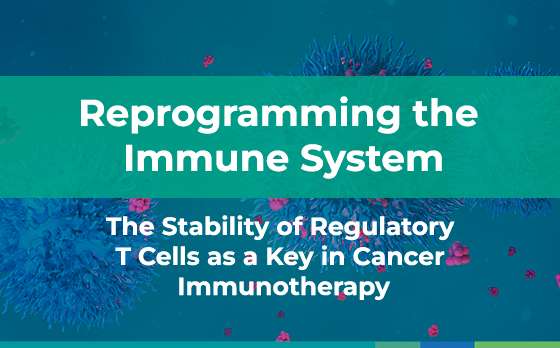Immunotherapy has revolutionized cancer treatment by harnessing the power of the immune system to combat tumors more effectively and specifically. However, this advancement faces significant barriers, particularly the ability of tumors to evade immune responses. One key strategy employed by tumors is the co-optation of regulatory T cells (Tregs), a subset of immune cells whose primary physiological role is to prevent excessive immune responses that could damage healthy tissues. In the tumor context, these same cells suppress antitumor immunity, creating a microenvironment that fosters cancer growth and progression.
Understanding how Tregs contribute to immune evasion in cancer is crucial for optimizing immunological therapies. For this reason, researchers such as Jee Hye Kang and Roberta Zappasodi, from Weill Cornell Medicine, have focused their efforts on exploring the mechanisms underlying the stability and plasticity of Tregs in the tumor microenvironment. In their recent work, these scientists review the complexity of intratumoral Tregs, highlighting their heterogeneity and plasticity. The study seeks to answer a critical question: how can we transform these cells, which normally suppress immunity, into allies against cancer?
The researchers analyzed data from preclinical studies using advanced techniques such as single-cell sequencing and murine models. Their findings shed light on the key factors that control Treg stability, such as metabolic signals, T-cell receptor (TCR) activation, and epigenetic modifications. The adaptability of Tregs to the tumor environment makes them an attractive yet challenging target, as any intervention must be precise to avoid adverse effects such as autoimmunity. To address this, the researchers propose an innovative perspective: instead of completely eliminating Tregs, they suggest reprogramming them to adopt pro-inflammatory characteristics and enhance an effective immune response against the tumor.
Kang and Zappasodi’s research integrates analyses of preclinical studies with advanced tools such as single-cell sequencing and metabolic approaches. They identified that Tregs in the tumor microenvironment are not homogeneous: they originate from different pathways, such as thymus-derived or peripherally converted cells, and have varied functions. A critical aspect of their work is the identification of three main pathways that control Treg stability: TCR signaling, metabolism, and epigenetics.
It was found that inhibiting the CARD11-BCL10-MALT1 complex, which links TCR signals to the activation of nuclear factor kappa B (NF-κB), reduces Treg-mediated immune suppression and renders them more fragile, promoting antitumor responses. This strategy, combined with immune checkpoint inhibitors such as anti-PD-1, proved effective in murine models of melanoma.
Another key finding is the role of metabolism in Treg stability. Tumor cells and Tregs compete for nutrients in the tumor microenvironment, such as glucose and lactate. It was found that inhibiting lactate transport or shifting Treg metabolism toward glycolysis impairs their suppressive capacity, thereby enhancing the antitumor activity of the immune system.
In the epigenetic realm, they highlighted how DNA and histone acetylation and methylation regulate Treg identity. Inhibiting enzymes such as EZH2, a methyltransferase associated with Treg stability, resulted in their destabilization and significant improvement in immune responses in experimental models. These epigenetic approaches could complement other therapies by enabling precise and temporary modulation of Tregs in the tumor microenvironment.

Figure 1. Regulatory T cells (Treg’s) and their modification mechanisms, based on the interaction of TCR receptors, metabolism and epigenetic modifications; which allow inhibiting the immunosuppressive activity and potentiating the intratumoral immune response.
This research provides a deeper understanding of the factors that control Treg plasticity and stability in cancer. It not only emphasizes the importance of Tregs as a therapeutic target but also offers a conceptual framework for designing more specific and effective immunotherapy strategies. By understanding and manipulating the complex mechanisms that regulate these cells, we could unlock new potential in the fight against cancer.
The future of immunotherapy envisions a scenario where Tregs are not merely seen as obstacles but as tools that, when properly controlled, can transform the way we approach this disease.
Main Reference:
Kang, J. H., & Zappasodi, R. (2023). Modulating Treg stability to improve cancer immunotherapy. Trends in Cancer, 9(11), 911–927. https://doi.org/10.1016/j.trecan.2023.07.015
Other References:
Nishikawa, H. and Sakaguchi, S. (2010) Regulatory T cells in tumor immunity. Int. J. Cancer 127, 759–767. DOI: https://doi.org/10.1002/ijc.25429
Oliveira, G., Stromhaug, K., Cieri, N. et al. Landscape of helper and regulatory antitumour CD4+ T cells in melanoma. Nature 605, 532–538 (2022). https://doi.org/10.1038/s41586-022-04682-5
Tzu-Sheng Hsu, Ming-Zong Lai, Hypoxia-inducible factor 1α plays a predominantly negative role in regulatory T cell functions, Journal of Leukocyte Biology, Volume 104, Issue 5, Nov 2018, Pages 911–918, https://doi.org/10.1002/JLB.MR1217-481R


